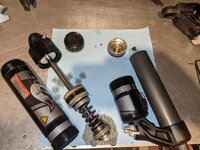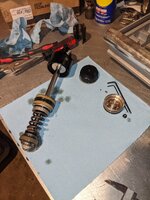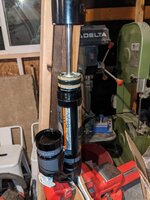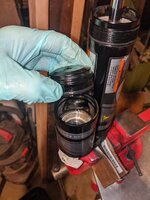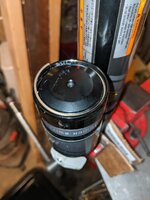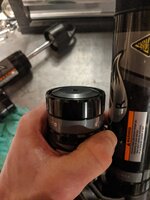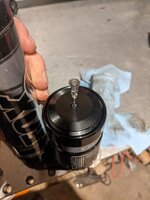Shipping delays and good snow, lead me to make my own seal head tool and improvise a syringe needle filling setup. Got the oil changed in all 4 QS3 shocks and the reservoirs pressurized. Pretty simple when it comes down to it.
0. Clamp shock in vise by the eyelet.
1. Release all air and nitrogen charge.
2. Unthread air can from end cap.
3. Depress reservoir cap to expose snap ring, remove snap ring with pick.
4. Use two screw drivers to pry reservoir cap up. Work out out completely.
5. 1/8" hex key removes bleed screw from IFP.
6. Use smaller hex key to remove set screw from seal head, note there is a small ball bearing under it, do not lose it!
7. Use seal head tool (slotted socket with two 3/16" diameter pins) to remove seal head from shock body. It's tight! Lefty losey.
8. Lift shock shaft out of the shock body. Rotating can help free it.
9. With a very firm grip with needle nose pliers grab the IFP and pull it out. Rotating can help.
10. Dump oil from shock body.
10.a. You can, but don't strictly need to, pull the air can off the shock body. I did to clean, but without the bullet tool it can be tricky to reinstall this (seal catches the shock body edge).
11. Clean and inspect everything. Replace parts that are questionable.
12. Reinstall air can. I used a little Slick Honey.
13. Pour oil into reservoir side, and main side.
14. Reinstall IFP to a depth of 1.45".
15. Carefully reinstall the shock rod. The wear strips tend to be hard to keep in place, a bent pick was helpful to gently guide them as they slid into the shock body. Once in place, tighten the seal head back into the shock body.
16. You want only oil between the bottom of the seal head and the IFP. I kept oil above both of them and slowly cycled the shock with the bleeders out. Oil will slowly accumulate above the IFP due to gravity, I used a syringe to move it above the seal head as needed. Once confident as much air as possible is out, reinstall both bleed plugs, and don't forget the little ball for the seal head.
17. Pour excess oil from the shock. No need to have oil in the reservoir or the air chamber.
18. Reinstall the reservoir cap and snap ring. Make certain it is fully seated.
19. Recharge the reservoir to 150 psi, ideally with nitrogen. I simply used air (shock pump and syringe needle), but I'll be back in these shocks soon when parts & tools show up.
20. Thread the air can back into the end cap.
21. Fill air chamber to desired pressure.
22. Reinstall on snowmobile.
This isn't a by the book way to do it but it made sense to me. Shocks feel 10 better with fresh oil and charge.



